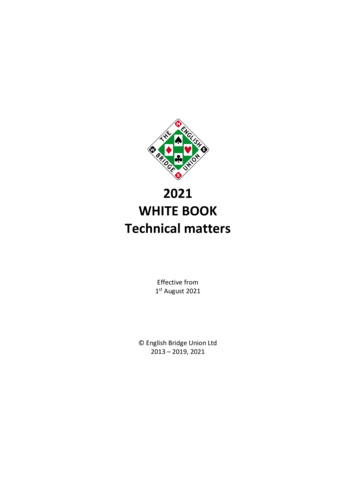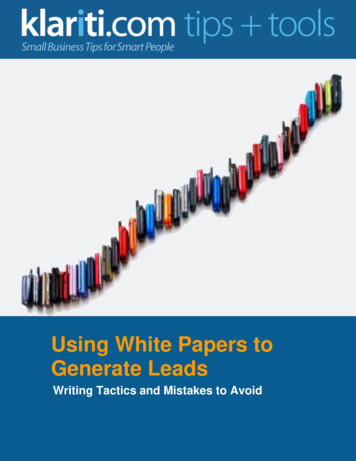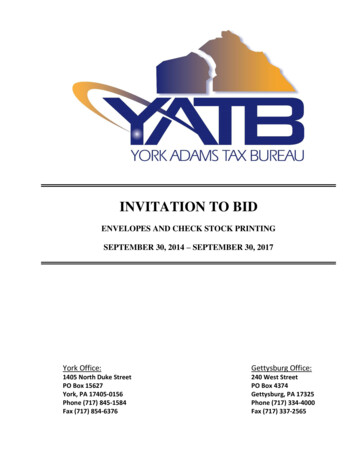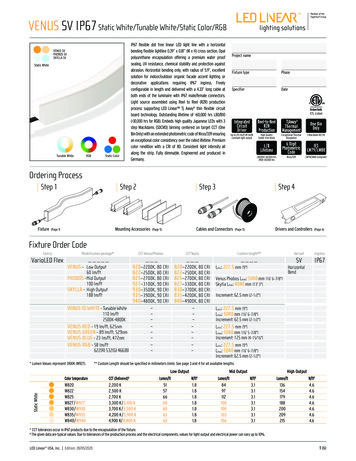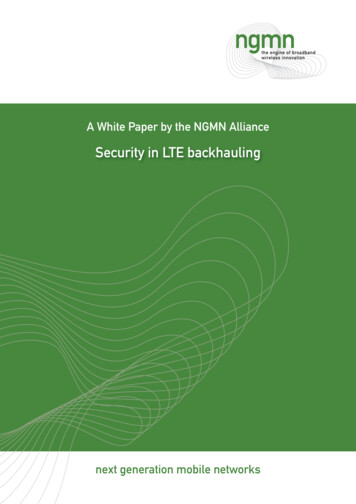
Transcription
A White Paper by the NGMN AllianceSecurity in LTE backhaulingnext generation mobile networks
Security in LTE backhaulingby NGMN AllianceVersion:1.0 FinalDate:29 February 2012Document Type:Final Deliverable (approved)Confidentiality Class:P – PublicAuthorised Recipients:N/AProject:P-OSB: Optimised BackhaulEditor / Submitter: Miguel Angel Alvarez, Frederic Jounay, Paolo VolpatoContributors:NGMN Optimized Backhaul Project GroupApproved by /Date:NGMN Board29 February 2012For all Confidential documents (CN, CL, CR):This document contains information that is confidential and proprietary to NGMN Ltd. The information may not beused, disclosed or reproduced without the prior written authorisation of NGMN Ltd., and those so authorised mayonly use this information for the purpose consistent with the authorisation.For Public documents (P): 2012 Next Generation Mobile Networks Ltd. All rights reserved. No part of this document may be reproduced ortransmitted in any form or by any means without prior written permission from NGMN Ltd.The information contained in this document represents the current view held by NGMN Ltd. on the issuesdiscussed as of the date of publication. This document is provided “as is” with no warranties whatsoever includingany warranty of merchantability, non-infringement, or fitness for any particular purpose. All liability (includingliability for infringement of any property rights) relating to the use of information in this document is disclaimed.No license, express or implied, to any intellectual property rights are granted herein. This document is distributedfor informational purposes only and is subject to change without notice. Readers should not design products based
AbstractThe adoption of packet based architecture for the LTE backhaul has brought to an increasedattention to security matters, often considered as critical issues to be addressed for the deploymentof LTE networks.This paper is an NGMN informative contribution on the subject and aims to provide a commonterminology and some high-level scenarios to introduce to Industry a few possible implementationsfor security in LTE backhauling.The attention has been put on the ways to assemble security mechanisms in a few scenariossuitable to address the security requirements of an LTE network. The “per interface” approach hasbeen adopted to analyze every scenario presented. The term “per interface” refers to LTEinterfaces (S1, X2), the core of this analysis, and the approach undertaken considers whathappens to every LTE interface when crossing some defined points in the backhaul network. Thisis covered in chapter 5The scenarios described in chapter 6 do not aim to be exhaustive; they should be taken as highlevel guidelines for Operators to define their own requirements and to what degree of security theyare looking at. To this extent, an overview of the meaning of trusted versus un-trusted networks isalso given.Security in LTE backhauling, Version 1.0, 29-02-2012page 2
Table of Contents 1. Introduction . 4 2. Definitions and abbreviations . 4 3. References . 4 4. Scope of the work . 5 4.1. ITU-T X.800 series recommendations. 5 4.2. Approach taken . 5 4.3. Trusted and un-trusted networks . 6 5. LTE backhauling security . 8 5.1. Architecture and security points . 8 5.2. LTE flows . 9 5.3. Threats . 10 5.4. Per interface application of threats to security points. 11 5.5. Security areas . 13 6. Security scenarios . 15 6.1. 6.1.1. 6.2. 6.2.1. 6.3. 6.3.1. 6.4. Scenario 1: Trusted domain . 15 Pros & Cons . 17 Scenario 2: IPsec for control plane . 18 Pros & Cons . 20 Scenario 3: IPsec for all telecom flows (Control Plane, User Plane) . 21 Pros & Cons . 22 The position of SecGW . 22 7. OAM security . 25 8. Other Requirements . 27 8.1. Security on synchronization plane . 27 9. Conclusion . 28 Security in LTE backhauling, Version 1.0, 29-02-2012page 3
1. IntroductionScope of this paper is to present some alternative security architectures (scenarios) to beconsidered in LTE backhauling. The content of this paper is informative; nevertheless somefunctions or mechanisms needed for the good implementation or operation of a network areaddressed. As such sometimes the term “requirement” is used to indicate a functional or logicalelement to be evaluated when dealing with an end-to-end security architecture in backhauling.This paper has been developed under the NGMN TWG P11 - P-OSB scope and relates to theother papers already published by the same workgroup.2. Definitions and abbreviationsAbisATMBGPCACCELogical interface between 2G BTS and BSCAsynchronous Transfer ModeBorder Gateway ProtocolCall Admission ControlCustomer EdgeCPECustomer Premises EquipmentCSGDSCPEPCGGSNGPRSGWCell Site GatewayDifferentiated Service Code PointEvolved Packet CoreGateway GPRS Support NodeGeneral Packet Radio ServiceGatewayHSPAHigh Speed Packet AccessIubLSPLTEMPLSMASGOSPFPPELogical interface between 3G BTS and RNCLabel Switched PathLong Term EvolutionMulti Protocol Label SwitchingMobile Aggregation Site GatewayOpen Shortest Path FirstProvider (Router)Provider Edge (Router)Per Hop BehaviourPlesiochronous Digital HierarchyPacket Over SonetPoint to Point ProtocolQuality of ServiceLogical interface between LTE BTSS1and packet coreSynchronous Digital HierarchySDHSecGW Security GatewayServing GPRS Support NodesSGSNServing GatewayS-GWTime division MultiplexTDMTraffic EngineeringTEUniversal MobileUMTSTelecommunication ServiceVirtual CircuitVCVirtual LANVLANVirtual Private LAN ServiceVPLSVirtual Private NetworkVPNVirtual Routing and ForwardingVRFVirtual Switching InstanceVSILogical interface between LTE BTSX2PHBPDHPOSPPPQoS3. References1.NGMN Alliance, “Next Generation Mobile Networks Beyond HSPA & EVDO – A white paper”, V3.0,December 2006 [available at www.ngmn.org]2. NGMN Alliance, “Next Generation Mobile Networks Optimized Backhaul Requirements”, August 14th,2008 [available at www.ngmn.org]3. NGMN Alliance, “LTE backhauling deployment scenarios”, paper under publication4. ITU-T X.800, “Security architecture for Open Systems Interconnection for CCITT applications”, March19915. ITU-T X.805, “Security architecture for systems providing end-to-end communications”, October 20036. 3GPP TS 33.102: "3G security; Security architecture", March 20107. 3GPP TS 33.210: "3G security; Network Domain Security (NDS); IP network layer security", June 20098. 3GPP TS 33.310: "Network Domain Security (NDS); Authentication Framework (AF)", June 20109. 3GPP TR 33.401, “3GPP System Architecture Evolution (SAE); Security architecture”,10. IETF RFC 4303, "IP Encapsulating Security Payload (ESP)", December 2005Security in LTE backhauling, Version 1.0, 29-02-2012page 4
4. Scope of the workCompared to the second and third generation of mobile services (2G/3G), the LTE securityrequires a different system protection. The adoption of a packet-based architecture for the LTEbackhaul network, the sometimes recognized lack of expertise when handling packet networks incontrast to circuit switched networks, this even worsened by a widespread know-how on attackmethods and availability of hacking tools have found an answer in the work done by 3GPP in somerelevant technical specifications, such as the TR 33.401 [9] and related documents.TR 33.401 and the related documents define the security architecture for LTE as well as the set offeatures and mechanisms to be implemented in the different network and service domains toobtain a level of security suitable for the support of the control and data plane of LTE by a backhaulnetwork. As an example the LTE flat architecture moves some functions previously in the controller(BSC and RNC respectively) directly into the eNodeB, exposing the service and the underlyingpacket backhaul network to potential security threats. Unlike in traditional radio networks which hadtheir own physical infrastructure, this is particularly perceived as an issue when a shared networkinfrastructure is employed, for example in case of coexistence of fixed and mobile services on thesame packet network. Moreover, the presence of the X2 interface, that supports direct handoveramong the vicinity eNodeBs, involves stronger security requirements on the nodes.Scope of this work is to discuss the security deployments in an LTE backhaul network and proposesome guidelines for the implementation of a security architecture compliant with the backhaulscenarios defined in other NGMN papers, specifically [3].After discussing, in chapter 5, how the analysis on LTE backhaul security has been performed andthe resulting requirements, chapter 6 introduces some architectures that operators might considerfor their own implementation of security. Chapter 7 also provides an high-level description securityfor OAM.4.1. ITU-T X.800 series recommendationsTo address the need of having a common security related terminology, the ITU-Trecommendations belonging to the X.800 family, and in particular X.805, have been extensivelyreferenced throughout this paper. They have been specifically used to group the requirements intosecurity areas, define the security threats, and map for every area and possible threats somesecurity mechanisms.Please refer to [4] and [5] for the classification and terminology used.4.2. Approach takenAmong the several available methods to define and assess the LTE backhaul security architecturethe current analysis took the “per interface” approach. Every LTE flow/interface (S1, X2) has beenmatched against the security requirements at every point into the backhaul network, as explainedlater.Security in LTE backhauling, Version 1.0, 29-02-2012page 5
For each of the architectures presented in chapter 3 a table summarizes the degree of fulfilment ofthe security requirements, as defined by ITU-T X.805 and the mechanisms that could beimplemented to obtain that level of security.4.3. Trusted and un-trusted networksOne of the basic questions to answer before evaluating what architecture is most suitable for abackhaul network is whether that network is considered trusted or un-trusted. This is key since, asstated by 3GPP in [9], for an un-trusted network it is mandatory to implement an increased layer ofsecurity than in trusted environments.Trusted (or un-trusted) networks can be defined in many different ways. One possible definition isbased on criteria related to the property or control of physical site locations, owing of the network,operation managed by a single administrative authority, but more remains (e.g. what degree ofnetwork security one operator wants to reach, assessment to define the cost to reach it, etc.).As a start point to support operators to evaluate how trusted their network is, a very high-leveldecision tree is proposed, without pretending of being exhaustive.Site securityYESNOOne authoritydomainYESTrustOne authoritydomainNO?YESOperator’sdecisionon otherparameters?NOUntrustFigure 1 – Decision tree for a trusted / un-trusted network based on physical aspectsAn high level decision strategy might start from the physical security of a site (cell site, centraloffice), including the ownership and/or a tight control of it (access, policies, etc.). A second stepconsiders whether a single organization manages the network, or, put in different terms, thenetwork can be organized as a single domain.If the two previous questions give a positive answer then it is likely that a network can beconsidered “trusted”. On the opposite, two negative answers might lead to an “un-trusted” network,not compliant with the two criteria of physical/logical security.Security in LTE backhauling, Version 1.0, 29-02-2012page 6
In between there is a grey area where the definition of trusted or un-trusted network might dependon other parameters, ranging from the operator’s attitude to deal with network security, marketrequirements or law enforcement policies, and a cost versus benefit assessment.In any case it is recognized that beyond the physical security aspects for any deployment it wouldbe necessary to run a dedicated assessment to assess risk, identify the mitigation needs, plan anddeploy controls and accept the residual risk.Security in LTE backhauling, Version 1.0, 29-02-2012page 7
5. LTE backhauling security3GPP has extensively analyzed the security for LTE services across an entire set of specifications(see as an example [6], [7], [8], [9]). Specifically [9] details the features that should be applied intoevery single function or service stratum to obtain a full-fledged security implementations.Whilst 3GPP mandates the implementation of those features into a backhaul network, consideredin general as a non-secure connectivity medium, Operators have the freedom either to enable thefeatures referenced by the specifications or leave them disabled.Depending on the willingness of Operators to enable such features, their attitude and many otherfactors, several security architectures can be found in backhauling, each with advantages anddisadvantages. To assess the degree of security of some possible implementations scenarios, thiswork starts analyzing the impact of security threats over the LTE traffic at the main backhaulinginterfaces, to detect which are the most suitable mechanisms to mitigate or block a possible attack.5.1. Architecture and security pointsThe general description of the LTE backhauling architecture has been detailed in [3]. For sake ofclarity, the same diagram is referenced here with the addition of the points (network elements orconnections) where backhaul security is analyzed.ONDomain of cessABCDEF1/F2GAggregationH1/H2IJKLMNFigure 2 – Network points considered in the analysisThe security points are listed and explained in the following table.Security in LTE backhauling, Version 1.0, 29-02-2012page 8
InterfaceNetwork pointCommentsAUser equipmentDelivery of service to user – Out of scopeBRadio access linkRadio access and transport – Out of scopeCeNBPoint of ingress to the network and service –Out of scopeDMEF UNI (eNB – Demarcationnode link)Transit of Ethernet framesEDemarcation nodeSwitching/routing of trafficF1Wireless (microwave) first mileTransit of Ethernet frames (on air, oftenscrambled and/or proprietary format)F2Wireline (fiber, copper) first mileTransit of Ethernet framesGPacket nodeSwitching/routing of trafficH1/H2Second mile - See F1/F2As F1/F2IPacket nodeSwitching/routing of trafficJAggregation networkEthernet transportKMASGSwitching/routing of trafficLCoreAny transport technology – Out of scopeMControllerService control and handling – Out of scopeNOAMLog alarms and events, SW distribution,configuration parameters – Out of scopeODHCP ServerIP address – Out of scopePSync MasterNetwork clock – Out of scopeQRadius serverAuthentication server – Out of scopeRHSSSubscriber data, authentication vectors –Out of scopeTable 1 – List of network points5.2. LTE flowsThe “per flow” is the approach taken to analyze the backhaul security; it follows the previousstatement of 3GPP and considers the impact, in the security domain, of every LTE flows when theycross some defined points into the backhaul network, as shown in the next paragraph.The key LTE interfaces considered are listed in the following table.Security in LTE backhauling, Version 1.0, 29-02-2012page 9
InterfaceS1-UScopeS1 User dataS1-CS1 Control paneX2-UX2-CX2 User dataX2 Control planeOAMManagement planeDetailDefines the user plane between eNBand Serving GateWaysUsed for signaling between the eNBand the MMEData plane distributed among eNBsSupports inter-eNB handoff with nopacket lossManagement traffic exchanged withnetwork elements belonging tobackhaulingTable 2 – List of interfaces5.3. ThreatsThere are many standards and documents that describe the attacks and risks intelecommunications networks. As mentioned earlier, this paper uses the security frameworkdefined by the ITU-T X.800/X.805 recommendations. The ITU-T X.800 threats model issummarized in the table below.ThreatsDestructionDescriptionGraphical representationDestruction of information and/ornetwork resource (DoS Denialof-Service)Corruption/Modification Unauthorized tampering with anassetRemovalTheft, removal or loss ofinformation and other resourceDisclosure/InterceptionUnauthorized access to an asset(eavesdropping)InterruptionNetwork becomes unavailable orunusableTable 3 - Threats modelSecurity in LTE backhauling, Version 1.0, 29-02-2012page 10
The focus of the threats analysis is on intentional attacks and in particular:x Insider attacks - abuse of administrator rights (eNB/CSG access)x External attacks via networks – from Internet or other PDN, from GPRS roaming exchangeor other PLMN, from an external transport network or external non-3GPP access network;x External attacks on physical access to the network – on the radio interfaces, tampering witheasily accessible devices (e.g. small cells), unauthorized physical access to network ports;x Attacks from mobiles.5.4. Per interface application of threats to security pointsMatching the threats defined in the previous paragraph with the LTE flows crossing the networkpoints shown in Figure 2, we obtain a first result described into the next table.NetworkS1-UpointDTampering, ampering, 2-UX2-CTampering, traffichijacking, injectwrong/false controldata,eavesdropping,destructionSpoofing of eNB identity,eNB impersonation,eavesdropping ofmanagement activities,management intrusionTampering, g, traffichijacking, injectwrong/false controldata, destructionUnauthorizedaccess, loss ofaccountability ofcontrol planeactivitiesUnauthorized access toCSG, impact on trafficsteering, DoS attacksagainst nodeTraffic hijacking, ifmanageability,X2 routed/switchedunauthorized modificationhereof configuration data, lossof configuration data andaccountability ofmanagement activitiesTraffic hijacking, ifX2 routed/switchedhereTampering, traffichijacking, injectwrong/false controldata,eavesdropping,destructionSpoofing of eNB identity,eNB impersonation,eavesdropping ofmanagement activities,management intrusionTampering, g, traffichijacking, injectwrong/false controldata, destructionAs point E, loss ofconfiguration data andaccountability ofmanagement activitiesDepending ontopology andbackhaulingscenarios X2steering might beimpacted, denial ofserviceUnauthorizedaccess, loss ofaccountability ofcontrol planeactivitiesSecurity in LTE backhauling, Version 1.0, 29-02-2012Depending ontopology andbackhaulingscenarios X2steering might beimpacted, denial ofservicepage 11
H1/H2Tampering, ring, g, traffichijacking, injectwrong/false controldata,eavesdropping,destructionSpoofing of eNB identity,eNB impersonation,eavesdropping ofmanagement activities,management intrusionTampering, g, traffichijacking, injectwrong/false controldata, destructionUnauthorizedaccess, loss ofaccountability ofcontrol planeactivitiesSee E, , loss ofconfiguration data andaccountability ofmanagement activitiesDepending ontopology andbackhaulingscenarios X2steering might beimpacted, denial ofserviceDepending ontopology andbackhaulingscenarios X2steering might beimpacted, denial ofserviceTampering, traffichijacking, injectwrong/false controldata,eavesdropping,destructionSpoofing of eNB identity,eNB impersonation,eavesdropping ofmanagement activities,management intrusionTampering, g, traffichijacking, injectwrong/false controldata, destructionSee E, loss ofconfiguration data andaccountability ofmanagement activitiesDepending ontopology andbackhaulingscenarios X2steering might beimpacted, denial ofserviceDepending ontopology andbackhaulingscenarios X2steering might beimpacted, denial ofserviceUnauthorizedaccess, loss ofaccountability ofcontrol planeactivitiesTable 4 – List of threats per network pointIn general, the closer the potential attack is to the core network, the less physical access methodsare required. In other words physical access methods are more involved to deal with potentialattacks brought from positions close to eNBs.This is a security focus for LTE features. The operator shall also manage security backhaulingnetworks form networks point of view. All access point shall have sufficient security rule to insurebackhauling security.Security in LTE backhauling, Version 1.0, 29-02-2012page 12
5.5. Security areasSecurity services can be grouped, according to ITU-T X.800/X.805, into a few categories whosescope is described in the next table.AreaDescriptionAuthenticationThis area provides for the authentication of a communicating peerentity and the source of dataAccess ControlThis service provides protection against unauthorized use ofresourcesTrafficconfidentialityand integrityData cannot be read by unauthorized parties or modified duringtransitReplay ProtectionData should not delivered multiple times, out of orderAvailabilityAvoid impacts over services, network elements and application dueto (un)intentional reason such injection of false traffic, attacks,spoofing, (D)DoSAccountabilityPrevent ability to deny that an activity on the network occurredCommunication securityEnsure information only flows from source to destinationPrivacyEnsure identification and the network usage is kept privateTable 5 – Security areasThe possibility of addressing one or more of the eight security areas defined in the previous tabledepends on what security mechanisms are available in a network. Literature often groups thesecurity methods in nine major categories, as shown in the columns of the next table. The tableaims at matching the security mechanisms with the areas described before. If an operator wishesto address one security area, then one or more security mechanisms have to be selected, to obtainthe implementation of the proper counter-measures to the threats listed in paragraph 5.4.The green cells in the table highlight that for addressing the service in one of the eight rows thesecurity mechanisms belonging to one of the nine categories need to be enabled. For sake ofclarity some examples, not exhaustive, of security mechanisms are listed into the green cells.Security in LTE backhauling, Version 1.0, 29-02-2012page 13
Service/mechanismCiphering (1)AuthenticationDigital signatureDSA, RSAAsymmetric encyph.AccountabilityMACPKI, X.509,RadiusTraffic paddingRouting controlMany encyph. algorithmsVLAN, VRFMany encyph. algorithmsVLAN, VRFNotarizationRecoverySHA1, SHA 256IPsecAvailabilityCommunication securityAuthentication exchangeAES, 3DES,A5/3Data integrityPrivacyData IntegrityVLAN ID, MAC addr.Access backup, alarmsPKI, X.509,RadiusVLAN, VRFDSA, RSA,ElGamalIPsecLOGactivityTable 6 – Examples of security mechanisms per area1.The common term to indicate this function is “ciphering” (which also includes “deciphering”). The name“encipherment” has been also maintained in this paper as it is referenced by ITU-T X.800 [4]As an example, if one operator needs to enable the authentication of the network elements part ofthe backhauling, then some mechanisms belonging to the “Digital signature”, “Data integrity” or“Authentication exchange” have to be enabled. From an implementation point of view, thiscorresponds to the usage of one or more mechanisms often related to the IPsec framework:algorithms for digital signature (i.e. DSA, RSA), for data integrity (e.g. MAC), certificate-basedmethods, etc.This table will be applied in the next chapter when dealing with network scenarios. For everyscenario, some examples of security mechanisms will be examined and explained.Security in LTE backhauling, Version 1.0, 29-02-2012page 14
6. Security scenariosThe scenarios presented in this chapter aim at highlighting different ways to combine the securitymechanisms introduced in the previous section to obtain a secure LTE backhauling.Three high-level scenarios are introduced:-A first scenario tries to answer to the necessity of a light security implementation, meaningwithout IPsec, leveraging on mechanisms already available in packet networks-The second presents IPsec for protecting the LTE control traffic (S1-C, X2-C), oftenconsidered as the most sensible for the service continuity-The third analyzes a full IPsec protection, both for control and user traffics.One point that will be discussed is the position of the Security Gateway (SecGW) applied to thetopologies described in [3].6.1. Scenario 1: Trusted domainThe key characteristic of this scenario is the absence of IPsec.This scenario might be considered by Operators perceiving their backhaul network as “trusted”.There may exist several motivations for that. One example, based on the decision tree presentedin paragraph 4.3, is given by an operator who relies on the “physical” aspects of security (e.g.entirely owns the backhaul infrastructure and relies on tight control policies to access sites).Another example could be represented by operators who are not willing to handle extra operationdue to the introduction of a security layer or that, after performing a risk assessment, determine therisk reduction that could be achieved by introducing IPsec does not justify the associatedexpenses.Also, this scenario might be considered for first LTE deployments provided that one operator isaware of the implications for enabling a security architecture afterwards, as pointes out in thepros/cons discussion.The scenario is shown in the next picture.Security in LTE backhauling, Version 1.0, 29-02-2012page 15
Figure 3: Scenario 1 logical architectureTransport of LTE flows relies on the same mechanisms and architectures shown in [3]. In theexample above a VLAN is considered to carry the Telecom bundle, but the case could begeneralized for pseudowires, L2 or L3 VPNs.Security should focus on:xRequirements against physical access;xRestricted access, strong authentication.Even if not widely implemented, some techniques for supporting ciphering/integrity at L2 could beenabled (e.g. 802.1AE MACsec for authentication and confidentiality of each packet exchangedlink by link). Those solutions are not commonly found in deployed networks.The next picture highlights the degree of security reachable by this scenario and shows some ofthe mechanisms that can be enabled to achieve it. It is worth noting that without encryption ordigital signatures techniques the services of authentication or confidentiality cannot be fulfilled(reason why the corresponding cells are filled with solid yellow, as a reminder for attention).Security in LTE backhauling, Version 1.0, 29-02-2012page 16
Service/mechanismCiphering AuthenticationDigital signature(1)(1)Accountability(1)Radius, password, smartcard(2)Traffic paddingRouting controlMany encyph. algorithmsVLAN, VRF, PW, firewallMany encyph. algorithmsVLAN, VRF, PW unication securityAuthentication exchange(1)Data integrityPrivacyData IntegrityVLAN ID, MAC@.IP@Access controlConfidentialityACL(1)Radius, password, smartcard(2)IDS/IPS,backup, alarmsVLAN, VRF, PW, firewall(1)(1)(1)LOGactivityTable 7 – Degree of security of scenario 1 and available mechanisms1.Security not applicable, unless mechanisms different
CSG Cell Site Gateway SDH Synchronous Digital Hierarchy DSCP Differentiated Service Code Point SecGW Security Gateway . "Next Generation Mobile Networks Beyond HSPA & EVDO - A white paper", V3.0, December 2006 [available at www.ngmn.org] 2. NGMN Alliance, "Next Generation Mobile Networks Optimized Backhaul Requirements", August 14th,






